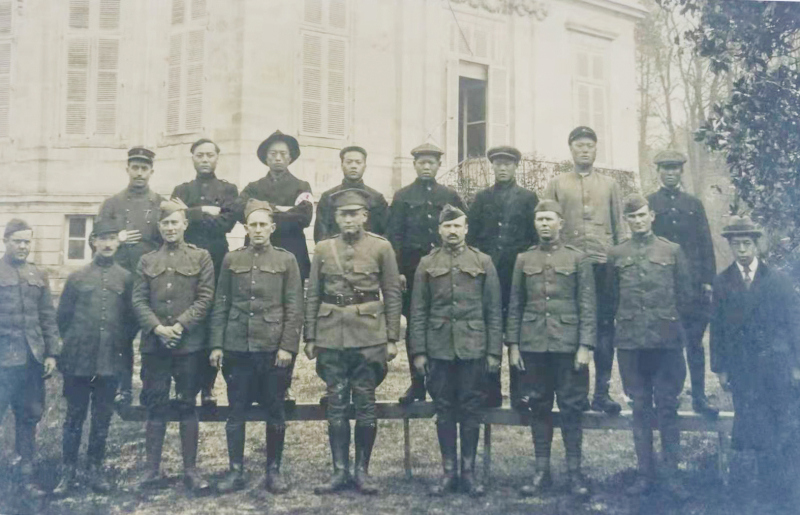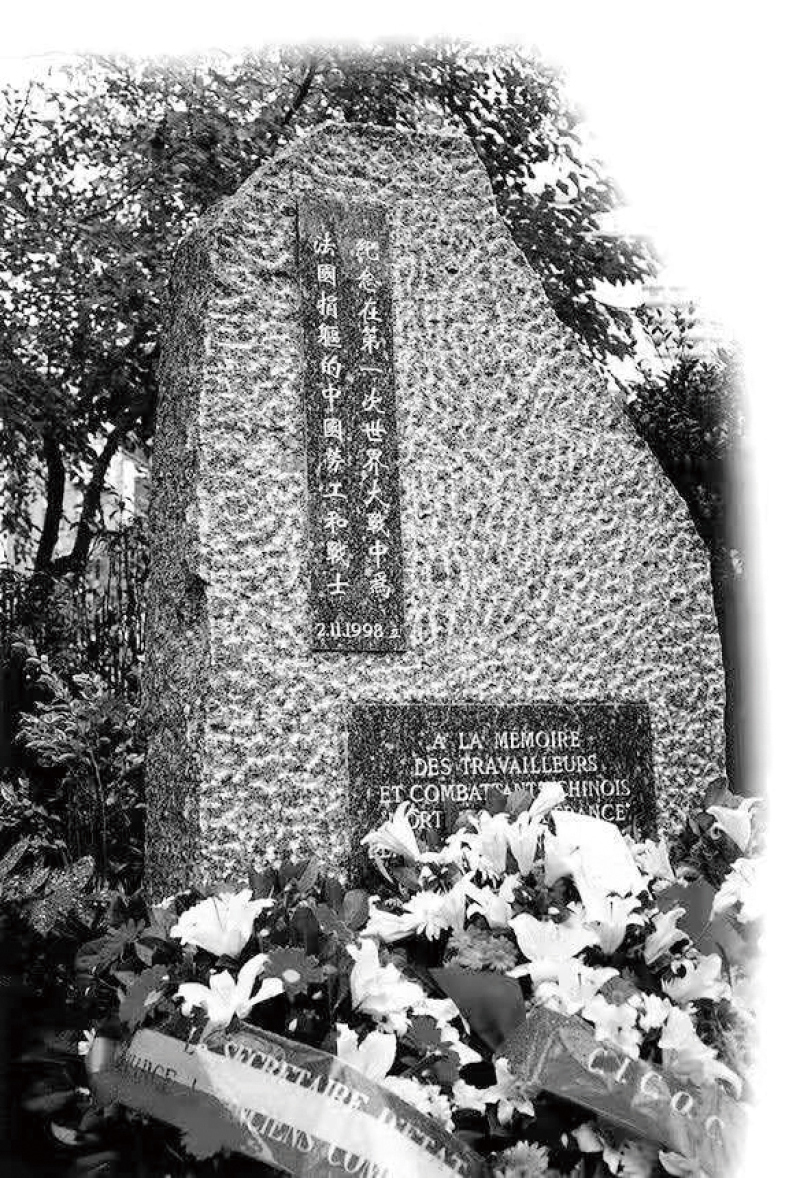I came to France in 1980. Since 1987, I have worked at 43 Rue de Temple Paris, where the French Overseas Chinese Association is located. Founded in 1972, it was the first Chinese association that had been set up after the establishment of diplomatic relations between China and France. It was also here that I met the old generations of Chinese laborers such as Zeng Guangpei and Lü Huchen and heard more and more stories about them that had never been made public. One by one, they passed away, and I suddenly realized that I should do something: to preserve their memories for the world before it was too late.

Zhu Guisheng (fourth from right, second row) during World War I. Photo taken in 1917
There were two specific events that prompted me to focus on the study of the history of Chinese laborers in France. The first one was that when Zeng Guangpei and Lü Huchen were awarded the Legion of Honor on the 70th anniversary of World War I in 1988, the history of Chinese Labor Corps gradually came to light. But the materials available to scholars were drying up. The second one was that some Chinese scholars went to France for academic exchanges, and found that the history of French Chinese was almost totally blank, which deepened my sense of mission in this regard. From then on, I have started to visit the surviving Chinese laborers and their descendants and collect historical resources on the subject. In fact, it was in 2002 that I found the last surviving member of the Chinese Labor Corps, the 106-year-old Zhu Guisheng.
To understand the history of Chinese in France, “Chinese Labor Corps in World War I” is a subject that nobody can skirt around. During World War I, at the request of the British and French allies, China sent 140,000 laborers to France to engage in field logistics services with the French people. Regrettably, it was little known due to historical reasons.
To uncover the history, I gathered a large number of first-hand materials by looking up documentaries, old photos and interviewing surviving Chinese laborers. In May 2010, my coauthored book Les travailleurs chinois pendant la Première Guerre Mondiale en France (Chinese Laborers in WWI in France) was finally published by Editions Pacifica, a Parisian publisher. It was a fitting tribute to those Chinese laborers, who should be remembered as they had made great contributions to and sacrifice for the French victory in World War I. During the war, some 10,000 Chinese laborers disappeared or perished on this piece of land.
Most of the survivors returned to China after the war, but over 3,000 of them chose to stay for France’s reconstruction. They lived near the Paris Gare de Lyon train station and formed the earliest Chinese community in France.
In 1944, World War II broke out and France became a battlefield once more. Chinese laborers like Zhu Guisheng, Zhang Changsong and others joined the army again, with their sons this time. The death of Zhu’s son was an indelible pain in his life. Zhu died in the French town of La Rochelle at the age of 106 in 2002, remembered by the mayor as its model citizen.
In the cruel war, Chinese laborers completed various battlefield tasks bravely. For instance, Zhu Binhou and Ma Yubao directly joined the French foreign corps and went to the front line. This is an example of Chinese direct participation in the war.
Zhu Binhou was born in 1885 in Jiangsu province in China. In 1913, he went to France for flying study. When World War I broke out in 1914, he took the initiative to join the French reinforcements and was incorporated into the foreign corps, registered under the name of Etienne. Soon after, due to his flying skills, he was transferred to the air force as a fighter pilot and promoted to sergeant in 1916. During his one-year and one-month service in the flight brigade, Zhu Binhou shot down two enemy planes, force-landed two, damaged one and shot down one reconnaissance balloon, which was highly praised and widely publicized in the whole army. Ma Yubao (or Ma Yi-pao) was born in 1894 in Yunnan province in China. He served in French foreign corps from 1916 and died in 1918 due to serious injury on duty. He was buried in World War I military cemetery in the town of Vis-sur-Aisne. Ma Yubao is the only Chinese of the 3,046-odd soldiers who rest here.
On January 18, 1919, the post-war Paris Peace Conference officially opened in Versailles. For their own interests, the victorious powers decided to sacrifice China’s rights and interests, compromising with Japan and forcing the Chinese delegation to sign the unequal treaty. In fact, the Japanese delegation even accused China of not having a single soldier to participate in the battle in Europe, so China was not qualified to make political demands. Gu Weijun (1888-1985), better known as Wellington Koo, the Chinese diplomat and representative at the conference, severely refuted the charge by citing the 140,000 Chinese laborers’ great efforts during the war. After receiving the news of unequal treaty, over 3,000 Chinese laborers and students in France marched to protest. Back in China, it led directly to the outbreak of the May 4th Movement, an event that changed Chinese history.

A monument was set up on November 12, 1998, in the 13th arrondissement of
Paris, commemorating the Chinese laborers who died for France in World War I
With the joint efforts of the overseas Chinese in France and friendly local people, the contributions of Chinese laborers have been gradually garnering public attention. From 1988 till now, several memorials have been erected in France to honor the Chinese laborers who had fought for the country.
Indeed, revisiting history could further deepen the relationship between China and France. The great achievements and friendship won by these hardworking Chinese laborers in France are the common memories of these two nations and should serve as an impetus for the building of a community with a shared future for humanity.
Born in 1953 in Yueqing, Zhejiang province, Mr. Ye Xingqiu is now living in France. He has published several books on overseas Chinese in France, including Chinois de France: Trois siecles d’historie (Chinese in France: Three Centuries of History) and Les travailleurs chinois pendant la Première Guerre Mondiale en France (Chinese Laborers in WWI in France).
Editor: Huang Yan